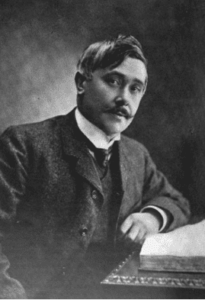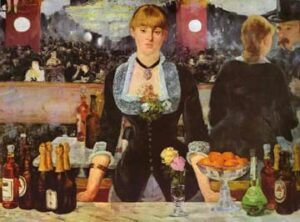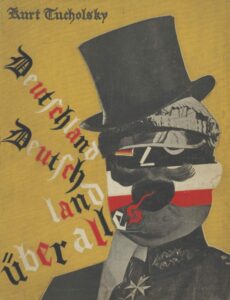The Duality of Art and Reality: A Critical Analysis of Maurice Maeterlinck’s “The Seven Princesses”
Introduction
The avant-garde movement of the 1900’s was an influential and pivotal movement in the world of art and expressionism. During this time, important artistic modes of expression were introduced and a new wave of influence was brought to light with movements such as, Dadaism, modernism, decadence, and symbolism. These movements helped shape the art that is currently presented in modern day because they paved the way for new-wave artists that exist in today’s culture. Besides art in the 19th century, different forms of art also came to the foreground such as stories and plays. In particular, one of the most influential writers and playwrights of the nineteenth century was Maurice Maeterlinck. Maeterlinck’s stories and plays were especially notable and influential for their role in the entertainment industry, and developing the avant-garde movement further. Perhaps one of Maeterlinck’s more influential works of the nineteenth century was his instalment in the 1897 little magazine: The Pageant. The play within the collection of stories is called “The Seven Princesses” and is a play that includes aspects of fairytale and fantasy. Through a variety of reviews and critical analyses, this play can be deemed as a work that was way ahead of its time, in the sense that it provided the reader with complex symbolism, vivid imagery, and beautiful diction, something that was almost unrecognizable to readers of this time. Through a scholarly review of Maurice Maeterlinck’s “The Seven Princesses,” and an analyzation of other academic sources, I will seek to provide an insight into Maeterlinck’s work that develops the theory that, not only did Maeterlinck develop the literary arts further during a time of artistic seclusion, but he emphasized the duality of art and reality through symbolism, which was nothing more than a foreign concept at the time.
About the Author: Maurice Maeterlinck as a Literary Prospect and Inventive Playwright

Black and white, 983 x 1,438, 564 KB
Maurice Maeterlinck was born on August 29, 1862 in Belgium, and died on May 6, 1949 in France. In the beginning, Maeterlinck studied law in school but later decided to pursue literature upon travelling to Paris. Maeterlinck was a symbolist writer who wrote various poems, essays, and plays during his years. Most of his works were written in French due to the mere instance that he was heavily influenced by French literary movements. His works were later translated to English as they began to gain a widespread audience. Maeterlinck’s first compilation of literary works were titled Serres chaudes (“Hothouses”). And his first play was titled La Princesse Maleine. With both these works being published in 1889, Maeterlinck broke through the mold and became more recognized for his talent in the general public. In continuance with his success, Maeterlinck published two one-act plays in 1890 titled, L’Intruse (The Intruder) and Les Aveugles (The Blind). Maeterlinck’s drama, Pèlleas et Mèlisande (1892), was a symbolistic masterpiece of its time and inspired an opera by Claude Debussy in 1902. Pèlleas et Mèlisande was also projected at the avant-garde theatre Thèâtre de l’Oeuvre, and depicts a story of hopelessness and melancholic drama between two unfortunate lovers. Although this play was written in the form of a prose, it could be considered “The most accomplished of all 19th-century attempts at poetic drama.” (“Maurice Maeterlinck.” Encylopædia Britannica, August 25, 2018, https://www.britannica.com/biography/Maurice-Maeterlinck. November 22, 2018). The poems and plays mentioned above do not even begin to capture the aspects of symbolism that are prevalent in Maeterlinck’s writing.
Maeterlinck and The Pageant (1897)

The 1987 little magazine The Pageant is a publication of multiple stories, plays, and artworks from various artists. This particular little magazine is set to be inspired by London art and culture. The Pageant is comprised of two volumes, the first one was published in 1896, and the second in 1897. With wood engravings, and a piece of artwork on almost every page, The Pageant served as a modern-day outlet for art and expression. Besides the art, the various plays and stories convey artistic forms as well. Many of the writers featured in The Pageant used symbolism, vivid imagery, and other artistic modes in their writing. Maeterlinck was amongst these artists, as he published a play titled “The Seven Princesses” in the second volume of The Pageant. The play, being a work of fantasy and fairytale, served as a key factor of the Symbolist Movement (1880’s).
The Symbolist Movement of the Nineteenth Century
The Symbolist Movement began in France, with French poets such as Stéphane Mallarmé, Charles Baudelaire, Arthur Rimbaud, and many others whom sought out to convert literature into an art form.The goal of the symbolist was to create an outlet for self-expression through descriptive language and metaphors. According to an article,
“The Symbolists wished to liberate poetry from its expository functions
and its formalized oratory in order to describe instead the fleeting, immediate sensations of man’s inner life and experience. They attempted to evoke the ineffable intuitions and sense impressions of mans inner life and to communicate the underlying mystery of existence through a free and highly personal use of metaphors and images that, though lacking in precise meaning, would nevertheless convey the state of the poet’s mind and hint at the “dark and confused unity” of an inexpressible reality.” (“Symbolism: Literary and Artistic Movement.” Encylopædia Britannica, May 22nd, 2013, https://www.britannica.com/art/Symbolism-literary-and-artistic-movement. November 25th, 2018).
In other words, poets of the nineteenth century not only sought out to write poetry, but they wished to turn poetry into a new mode of expression; one that would completely capture human existence and emphasize the human experience on earth. They accomplished this by using figurative language and metaphorical descriptions to transform the human experience into an art form. Maeterlinck’s play, “The Seven Princesses”, is an excellent example of the prevalence of symbolism in early works of the nineteenth century.
Symbolism in Maeterlinck’s “The Seven princesses”
Maeterlinck’s “The Seven Princesses” is a play that introduces many important literary modes in its writing. The play is comprised of five general characters; The King, The Queen, The Prince, The Messenger, and The Seven Princesses. The play opens in a large hall covered in white marble within a castle. The seven princesses of the castle are laid out on the seven steps of the hall in perfect unison while they sleep. In summary, the whole play consists of The Queen trying to convince The King and The Prince that the seven princesses are not only sleeping, but they must be unwell because they haven’t been awake for a long time. The climax of the play is when The Prince finally attempts to go into the room and wake the princesses with a stone. Upon doing this, only six of the princesses wake from their slumber and the last one, Ursule, continues to lay there almost breathless. While this is happening, there are sounds of sailors chanting and a ship approaching with no context as to what is actually happening. Suddenly, the play just ends with the curtains dropping; which creates a haunting ambiance as to what may have just happened.
While reading this play, I began to notice that Maeterlinck uses very descriptive and figurative language when describing settings. Some examples of this are when he describes the greenery that surrounds the castle. An example of a vivid setting within the text is when Maeterlinck says, “The sun is setting : and in the distance is seen a black marshy country, with stagnant pools and forests of pine and oak. Behind the palace, between two huge willows, is a sombre, grim-looking inflexible canal, along which a large war-ship is seen advancing” (The Pageant, 1897. Maeterlinck 163). In this paragraph alone, Maeterlinck uses expressive and specific words to describe the setting, such as, marshy, stagnant, sombre, grim-looking. These words help to, not only describe a setting, but make the reader feel the setting. Perhaps the reader can picture a dark forest, or can physically feel the warmth of the setting sun on their skin. This is an example of Maeterlinck placing art and reality in the same realm because he turns his words into an art; something that the reader can actually picture instead of just words on a paper.
Richard Hovey writes a scholarly translation of Maeterlinck’s “The Seven Princesses” and proceeds to explain the connection between Maeterlinck and modern symbolism. This source takes a more philosophical approach to the analyzation of Maeterlinck’s works. It also describes Maeterlinck’s history with art, symbolism, and reality, which is the foundation for my critical analysis of The Seven Princesses. Hovey states that, “Two things individualize Maeterlinck from the rest of the school, — the peculiarity of his technique and the limitation of his emotional range. His conceptions are romantic to the last degree, and so also is their setting” (“The Plays of Maurice Maeterlinck: Princess Malein; The Intruder; The Blind; The Seven Princesses Translated by Richard Hovey.” Richard Hovey, 2008, https://babel.hathitrust.org/cgi/pt?id=mdp.39015013392397;view=1up;seq=21. November 26th, 2018). Hovey is ultimately saying that Maeterlinck’s romantic and metaphorical language not only romanticized his works, but distinguished him from other writers during this time. Maeterlinck offered a unique view into the world of literature and playwriting.
The use of the Colour white in Maeterlinck’s “The Seven Princesses”
In reading “The Seven Princesses,” the colour white really stood out to me and I realized that it is mentioned several times throughout the text to describe the princesses, scenery, and human attributes. While reading I could not help but wonder whether the colour is present simply for aesthetic purposes, or because there is an underlying concept that Maeterlinck was

trying to convey in the play. Examples of this in the text are, “white robes” (Maeterlinck, 163), “how white your beard is!” (164), “white shadows” (164), and “how white they all are!” (164). It almost seems as if everything that exists within the castle is under a white light, and everything on the outside, such as the scenery, is dark and haunting, as mentioned earlier. In The Aesthetics of the Windshield: Proust and the Modernist Rhetoric of Speed by Sara Danius, Danius discusses the relationship between Maeterlinck and aestheticism. In other words, how Maeterlinck sought out to convey real experiences in his works by merely using words that are descriptive by nature. Maeterlinck chose to write artistic works during a time that was confined to resistance and limitation. In her book, she says, “Both Maeterlinck and Mirbeau explore the syntax of velocity, seeking to convey a sort of lived experience to which the medium of the printed word is stubbornly resistant: the bodily experience of speed. Both writers thus contemplate a representational problem: how the formal level of description may call forth what is suggested on the level of enunciation” (“The Aesthetics of the Windshield: Proust and the Modernist Rhetoric of Speed. Vol.8, no.1, pp 99-126. 2001, https://muse-jhu-edu.ezproxy.lib.ryerson.ca/article/23362. November 26th, 2018). This ultimately states that Maeterlinck not only sought out to create fantastic works of literature, but he also wanted to create something with real meaning, he wanted to create something bigger for his readers.
Conclusion
In my critical analysis of Maurice Maeterlinck’s “The Seven Princesses,” and Maeterlinck’s role in the avant-garde and symbolist movement, I have concluded that Maeterlinck was not only a literary prospect, but a writer who wanted to involve his readers in his works. It has become evident that the text is heavily influenced by art through artistic language and visualizations. Throughout the work, Maeterlinck not only describes things in a poetic fashion, but creates vivid scenarios in which the reader can physically place themselves in, which was somewhat of a foreign concept to works of this nature at the time. With the help of Maeterlinck, symbolism and art have become a massive aspect to literature and are favourable amongst many.
Works Cited
“The Aesthetics of the Windshield: Proust and the Modernist Rhetoric of Speed. Vol.8, no.1, pp 99-126. 2001, https://muse-jhu-edu.ezproxy.lib.ryerson.ca/article/23362. November 26th, 2018
“The Pageant”. Vol 2, 1897, pp 164-184. November 26th, 2018.
“The Plays of Maurice Maeterlinck: Princess Malein; The Intruder; The Blind; The Seven Princesses Translated by Richard Hovey.” Richard Hovey, 2008,
https://babel.hathitrust.org/cgi/pt?id=mdp.39015013392397;view=1up;seq=21. November 26th, 2018
“Maurice Maeterlinck.” Encylopædia Britannica, August 25, 2018,
https://www.britannica.com/biography/Maurice-Maeterlinck. November 22, 2018
“Symbolism: Literary and Artistic Movement.” Encylopædia Britannica, May 22nd, 2013, https://www.britannica.com/art/Symbolism-literary-and-artistic-movement. November 25th, 2018
